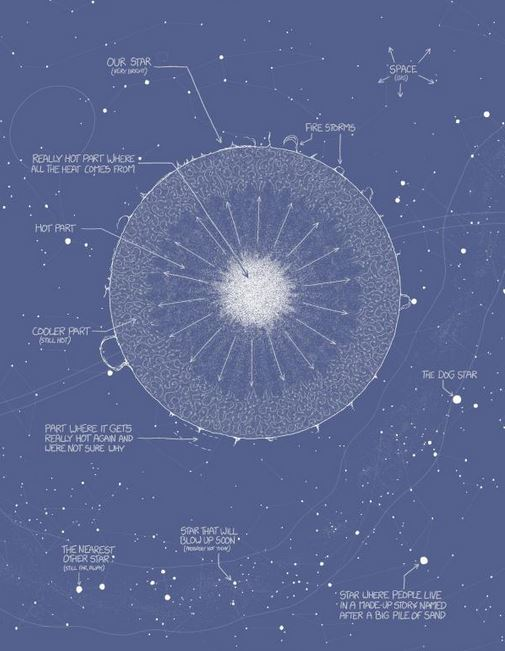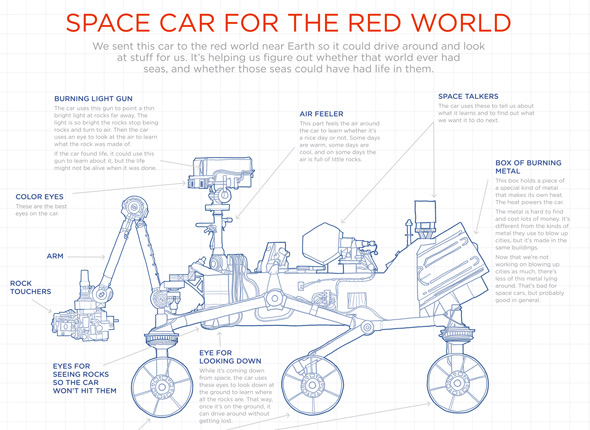Thing Explainer
Contents
| |
This explanation may be incomplete or incorrect: Needs touching up with links If you can address this issue, please edit the page! Thanks. |
Introduction
Thing Explainer: Complicated Stuff in Simple Words is a book by Randall Munroe where things are explained in the style of Up Goer Five (which is also included in the book), using only blueprint like drawings and a vocabulary of the 1,000 (or ten hundred) most common words in the English language. Randall found his own method to determine which words would go on his list, a list that is revealed in the book.
The book will among other explore computer buildings (datacenters), the flat rocks we live on (tectonic plates), the things you use to steer a plane (airliner cockpit controls), and the little bags of water you're made of (cells). See a summary below and also the entire index from the book listing all the 45 different explanations.
Thing Explainer is Randall's second published book, not including xkcd comic books, which he announced on May 13th, 2015 in the blag following the amazing success of his what if? book based on the what if? blog.
The book is a collection of diagrams and line drawings similar in style to the Up Goer Five comic, which can also be purchased as a poster. It was published by Houghton Mifflin Harcourt on November 24th and is available from among others Amazon to which a link has been posted on xkcd for a long time.
Release day
On the day of the book's release (even though it was a Tuesday) Randall also released the comic 1608: Hoverboard, which was a direct celebration of the books release (it says so in the comic). But it was far from being a small or normal comic! It was the first "real" game comic released on xkcd (albeit not the first interactive comic). In the style of 1110: Click and Drag it was possible to move around in a very much larger picture than what was shown in the frame. But this is not done by clicking and dragging though, instead the user controls Cueball on a hoverboard (hence the title of the comic) by using the arrow keys.
There are many themes and references throughout the game, but the two main themes are Star Wars (the largest part to the right part) and The Lord of the Rings to the left. Several references goes back to the book from this comic. These are listed in the explanation for the hoverboard comic.
On the release day Randall also released a simple writer that would only accept the thousand words listen at the back of the book under The ten hundred words people use the most. In this way others can try to create similar explanations themselves.
Summary
Have you ever tried to learn more about some incredible thing, only to be frustrated by incomprehensible jargon? Randall Munroe is here to help. In Thing Explainer, he uses line drawings and only the thousand (or, rather, “ten hundred”) most common words to provide simple explanations for some of the most interesting stuff there is, including:
- food-heating radio boxes (microwaves)
- tall roads (bridges)
- computer buildings (datacenters)
- the shared space house (the International Space Station)
- the other worlds around the sun (the solar system)
- the big flat rocks we live on (tectonic plates)
- the pieces everything is made of (the periodic table)
- planes with turning wings (helicopters)
- boxes that make clothes smell better (washers and dryers)
- the bags of stuff inside you (cells)
How do these things work? Where do they come from? What would life be like without them? And what would happen if we opened them up, heated them up, cooled them down, pointed them in a different direction, or pressed this button? In Thing Explainer, Munroe gives us the answers to these questions and so many more. Funny, interesting, and always understandable, this book is for anyone—age 5 to 105—who has ever wondered how things work, and why.
Things in this book by page
Below is the complete index of the book, with the simple title first. (Then follows the translation of this to normal language in brackets, with a wiki link to the most relevant page, based on the books material rather than the actual title). After "…" follows the page number for the start of that title as listed in the book:
- Pages before the books starts (Introduction) … vii
- Shared space house (International Space Station) … 1
- Tiny bags of water you’re made of (Animal cell) … 2
- Heavy metal power building (Nuclear reactor) … 3
- Red world space car (Curiosity Rover) … 4
- Bag of stuff inside you (Human torso) … 6
- Boxes that make clothes smell better (Washing machine and dryer) … 7
- Earth’s surface (Physical map of the Earth) … 8
- Under a car’s front cover (Car engine) … 11
- Sky boat with turning wings (Helicopter) … 13
- The US’s laws of the land (US Constitution) … 14
- The US
’S Laws of the Land (USS Constitution) … 15 - Food-heating radio box (Microwave) … 16
- Shape checker (Padlock) … 17
- Lifting room (Elevator) … 18
- Boat that goes under the sea (Submarine) … 19
- Box that cleans food holders (Dishwasher) … 20
- Big flat rocks we live on (Tectonic plates) … 21
- Cloud maps (Weather maps) … 22
- Tree (Tree) … 23
- Machine for burning cities (Nuclear bomb) … 24
- Water room (Toilet and sink) … 25
- Computer building (Data center) … 26
- US Space Team's Up Goer Five (Saturn V rocket) … 28
- Sky boat pusher (Jet engine) … 30
- Stuff you touch to fly a sky boat (Cockpit) … 31
- Big tiny thing hitter (Large Hadron Collider) … 32
- Power boxes (Batteries) … 33
- Hole-making city boat (Oil-rig) … 34
- Stuff in the Earth we can burn (Mines) … 35
- Tall roads (Bridges) … 36
- Bending computer (Laptop) … 37
- Worlds around the sun (Solar system) … 38
- Picture taker (Camera) … 40
- Writing sticks (Pen and pencil) … 41
- Hand computer (Smart phone) … 42
- Colors of light (Electromagnetic spectrum) … 43
- The sky at night (Night sky) … 44
- The pieces everything is made of (Periodic table) … 47
- Our star (Sun) … 49
- How to count things (Units and measurement) … 50
- Room for helping people (Hospital bed) … 51
- Playing fields (Athletic fields) … 52
- Earth’s past (Geologic periods of Earth) … 53
- Tree of life (Life’s family tree) … 54
- The ten hundred words people use the most (The ten hundred most common words in our language) … 57
- Helpers (Acknowledgments) … 63
- Sky toucher (Skyscraper) … 65
There are 48 entries, but with the introduction, the list of used words and the acknowledgments taking up three, the total ends up at 45 explanations.
Book Cover
Cueball can be seen on the cover overlooking some of the labeled pictures. It was thus already early clear that the book would explore the themes labeled on the front cover which includes astronomy, constellations, and geology.
There are several funny "explanations" on the cover, like labels on arrows pointing to the title and to Randall's name explaining that this is:
- Big words that tell you what this book is
- My name
The back cover of the book was also available:

Preview Pages
- Part of the Curiosity entry (note that there where not used red color inside the book, only blue):
Promotion at the top of the xkcd home page
- At the time the comic 1612: Colds came out, the top part of xkcd had been changed to promote the book.
- The entire section was a link to the book on amazon.com
- It was later moved to bottom section of xkcd:
Discussion
Ooooh, I know I get this one for x-mas, but there is soooo long until then... Nice to have something you really want for x-mas again. Only 20 more days to go. Can't wait.--Kynde (talk) 13:06, 4 December 2015 (UTC)
I put in the promotional picture. If someone could make it appear smaller I would appreciate this. I'm not sure how to do this without changing the file's resolution. Which I do not wish to do. It should be possible to see this version of the picture by opening the file. --Kynde (talk) 13:09, 4 December 2015 (UTC)
If the 1000 (ten hundred) word vocabulary is still too complex and you want to explain things in even simpler terms, you might take a look at the learnthesewordsfirst.com dictionary. It explains the 2000 most common English words using a set of only 360 words (the "semantic atoms and molecules" from the lessons). It is intended for 2nd-language learners, but interesting from the perspective of explaining things using reductive paraphrase. Lexyacc (talk) 23:31, 4 July 2016 (UTC)
I am pretty sure that in between the solar panels on the "shared space house" is the barrel boy from comic 1108.162.212.95
I wish for explanations for Thing Explainer, using more words. For instance, when explaining cells, I'm not sure what is the "bag filler" (the Golgi apparatus? but does it make bags of death water aka lysosomes), the strange boxes (???), the empty pockets (???), the doping substances they produce (???). It also took me a while to guess and google what ships visited the ISS. There, the "big carrier from many countries" seems the European ATV (https://en.wikipedia.org/wiki/Automated_Transfer_Vehicle), but that flew to the ISS 5 times, not 4. Since I'm clueless and Munroe isn't, I must be missing something. --Blaisorblade (talk) 20:39, 7 September 2019 (UTC)
- Hm, the empty boxes are probably vesicles and vacuoles, including secretory vesicles (https://en.wikipedia.org/w/index.php?title=Secretory_vesicles&redirect=no), used to make hormones including steroids. While I finally found this out, each time it takes googling and luck — googling the nontechnical terms fails; here I looked at https://commons.wikimedia.org/wiki/File:Animal_Cell.svg. --Blaisorblade (talk) 20:48, 7 September 2019 (UTC)



